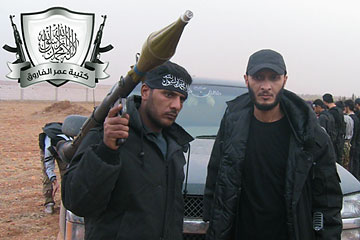
Khalid al-Hamad, left, in an undated photo that originally appeared on the website of the Syrian rebel group, the Independent Omar al-Farouk Brigade, which he commands.
(5 of 6)
Al-Hamad is commander of the independent Omar al-Farooq Brigade, a fighting force of uncertain numbers but fierce reputation in Homs. That city, and the neighborhood of Baba Amr in particular, has seen some of the most brutal fighting of the war, a legacy apparent in the reprisal-heavy footage coming out of the area. The video of al-Hamad biting into the soldier's organs was filmed on March 26, according to embedded data retrieved by Human Rights Watch. It was smuggled over the Lebanese border by a rebel fighter close to al-Hamad who asked not to be identified for fear of speaking without permission. When he showed the video to TIME reporters some days before it was posted online, the fighter looked on with evident pride. "I don't have a problem slaughtering the Alawites and eating their organs because of what I have seen from them," he tells TIME. Two years of war, he says, have taken a psychological toll. "Many people have reached a point where they can do worse than Abu Sakkar."
Rebels who have fought alongside al-Hamad describe him as a fearless combatant who honed his considerable battle skills in Iraq, fighting the U.S. military. But many Islamist fighters--and not just those in Syria--claim similar histories, which are impossible to substantiate. Al-Hamad says he fought in Iraq but isn't sure whether he killed any Americans.
A construction worker by trade, he fought in February 2012 with a group known as al-Farooq Brigade, one of the FSA's most effective units, during the battle for Baba Amr, a pivotal moment in the Syrian war. Al-Hamad was made commander of the rebels' prison, where he earned grudging respect for his ability to extract intelligence from captured regime soldiers, often employing brute force. One rebel who fought in Baba Amr says that if al-Hamad suspected any captives of having killed his comrades, he would murder them.
In October 2012 al-Hamad took three of the most extreme units under his command in al-Farooq Brigade, split off from the group and named his new unit the Independent Omar al-Farooq Brigade, after a senior al-Qaeda operative killed in Iraq in 2006. Despite the name, the group has no formal ties to al-Qaeda or its Syrian affiliate, al-Nusra Front. Early victories against regime forces helped al-Hamad's group amass a considerable array of rockets, trucks, guns and mortars, say other fighters. In rebel circles, a commander's arsenal is as important as his leadership skills, if not more so.
By the time he made the video, al-Hamad's exploits had attracted a sizable following online. His group has a slick website, complete with videos and photographs, poetic descriptions of battles won and lost and paeans to dead comrades. His supporters were quick to defend his desecration of the dead soldier, arguing that it was merely an act of revenge. Abu Jaafar Homs, a well-known antiregime activist in Homs, posted a photo of himself sitting next to al-Hamad and praised him for his bravery. He chastised those who were criticizing the commander: "No one is allowed to talk about Abu Sakkar."
